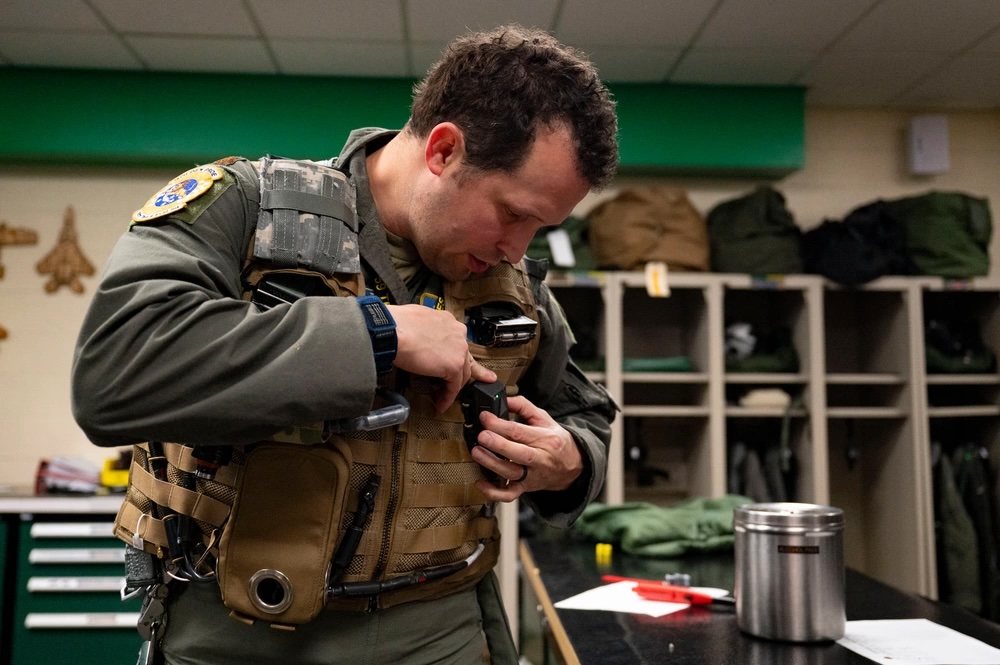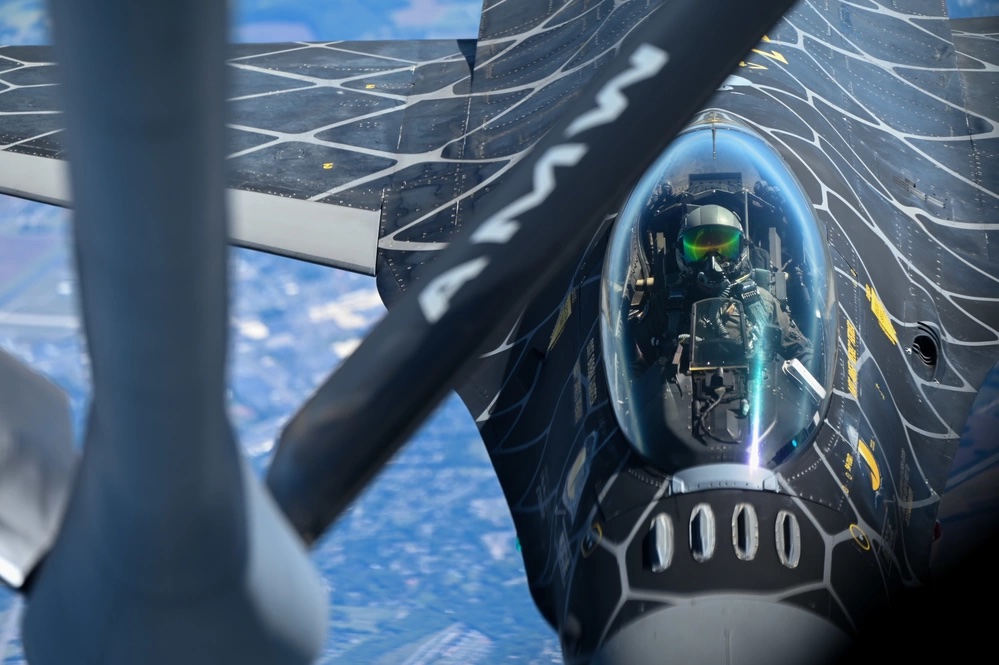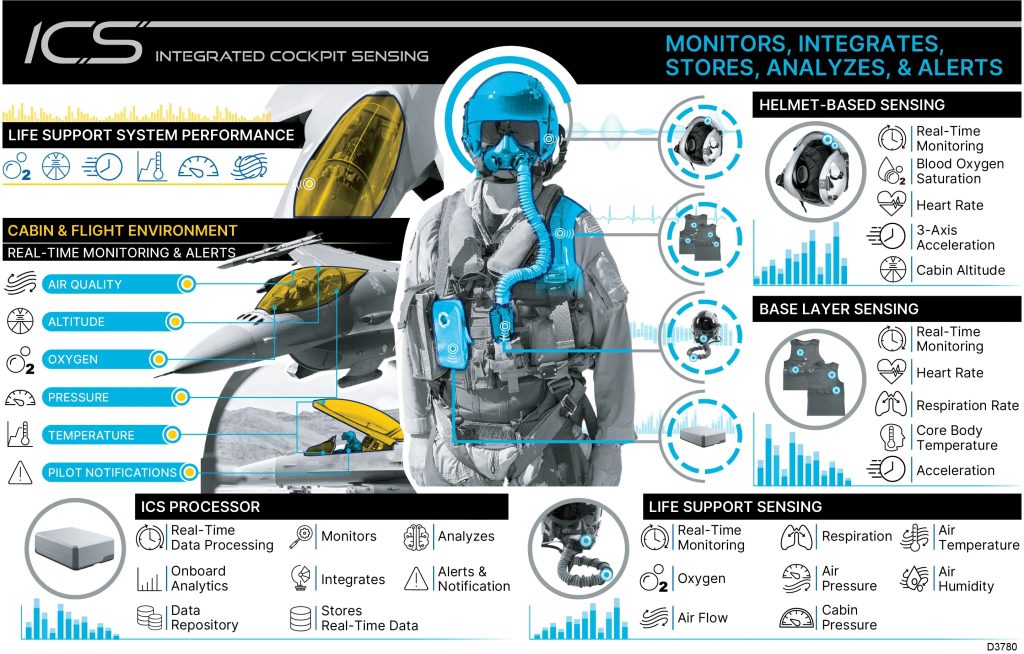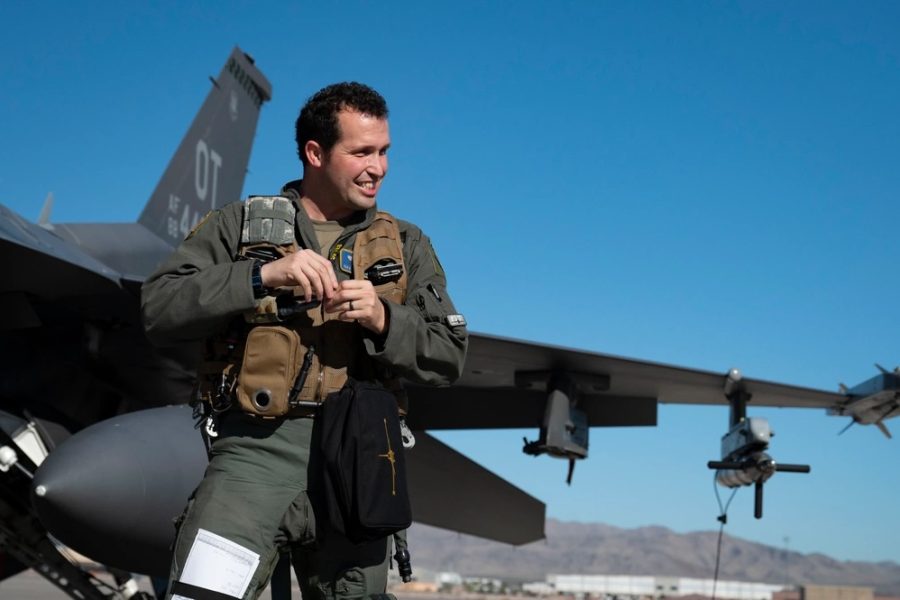Air Force F-16 pilots are testing out new sensors that could help maximize their performance and avoid deadly accidents while flying fast under heavy G-forces and stressful conditions.
Developed by the Air Force Research Laboratory, the Integrated Cockpit Sensing (ICS) system measures a pilot’s blood oxygen levels, heart rate, breathing rate, skin temperature, and other markers that show how their bodies are faring in flight. F-16 pilots from the Air Force Test Pilot School (TPS) at Edwards Air Force Base, Calif., and the 59th Test and Evaluation Squadron and 422nd Test and Evaluation Squadron at Nellis Air Force Base, Nev. took the system for a spin in a series of tests from January to March.
“We wanted to be able to help the ICS team accelerate their technology through flight tests,” said Wei “Fug” Lee, TPS director of research and the lead adviser for the project, said in an April 15 press release. “The goal is to demonstrate the ICS’s ability to measure physio and environmental data and assess its utility in recognizing physiological insults,” which is the medical term for physical or mental injuries or maladies.
While military cockpits are full of instruments reporting the health of the airplane, there are not as many tools for objectively assessing the health of the pilot. That can be a problem given the high physical demands of combat flying and the small margin for error when flying high-performance aircraft.
“This, contrary to popular belief, is a sport in all the sense of the physicality of the word,” Capt. Travis Worden, an F-16 pilot with the 422nd TES, said in a 2022 YouTube video about human performance sensing with Hasard Lee, a former F-16 pilot who currently flies the F-35.
Under the G-forces and mental focus of dogfight training, “my heart rate is going to increase, my bodily response and my temporal distortion is going to increase, and you are going to see how much more difficult it becomes for me to think, talk, and communicate,” Worden added.
Indeed, sensors on the pilot’s ears, forehead, and torso showed that his heart rate, which averages 50 beats per minute at rest, rose to around 120 during takeoff and spiked to nearly 160 during defensive dogfighting practice.
“I had no idea that our heart rates are like 120 just when you’re taking off, not doing anything extreme,” Lee said in the video.

That lack of fidelity on aircrew human performance data leaves holes in many investigations of deadly aircraft mishaps.
“Due to poor data collection and analysis, the services and the Department of Defense are missing out on valuable opportunities to reduce risk, prevent mishaps, and optimize human performance,” wrote the National Commission on Military Aviation Safety in a 2020 report.
Jet pilots across the military have long struggled with hypoxia (low oxygen), dehydration, temporal distortion, mental exhaustion, spatial disorientation, and hyperventilation. But the wide range of physiological episodes, plus pilots’ own reluctance to report episodes for fear of being grounded, and the lack of coordination between the services to study the problem “made finding root causes extraordinarily challenging for researchers,” the commission wrote.
To make matters worse, pilots may not be aware they are having an episode until it is too late. For example, one of the symptoms of hypoxia, which can arise if there is an issue with the pilot’s oxygen system, is a “sense of euphoria,” according to the Federal Aviation Administration.
“These subjects can’t write their name intelligibly, or even sort a deck of cards by suits … yet, they think they’re doing just fine!” the FAA wrote about people experiencing hypoxia.
Since pilots often lose awareness of their own condition, human performance systems need a way of alerting them when something is wrong, much like how pilots hear an alarm or a horn when their altitude is too low or they are approaching stall speed or running low on fuel. In the YouTube video, the system included headphones that emit a beeping noise when it detects hypoxia symptoms such as low blood oxygen levels.
“For once with these key low-cost innovations, I, as the most lethal aspect of this airframe, can maximize my own lethality and survivability by knowing when I might be in a life-threatening situation,” Worden said.

The findings of the report and a long run of hypoxia-related mishaps in the late 2010s inspired AFRL and the test community to start working on the problem, said Lt. Col. Robert Russell, commander of the 422nd TES.
“There are a lot of qualifiers like ‘likely’ and ‘possibly’ because while we collect millions of data points on the airplanes we fly, we monitor and collect zero data on pilots,” he said in the release.
The British defense manufacturer BAE Systems helped build ICS, which integrates sensors in the cockpit and in the pilot’s helmet, oxygen system, and clothing. According to BAE, the cockpit sensors track air quality, pressure, and other factors while the body sensors monitor blood oxygen levels, heart rate, body temperature, humidity, breathing rate, and other metrics. A smartphone-sized processor on the pilot’s chest rig processes and stores that data and alerts pilots when something is wrong.
“It aggregates … basically a bunch of markers that provide context and help us understand how the pilot is responding to what he or she is asked to do,” Chris Dooley, lead ICS engineer with the AFRL Human Effectiveness Directorate, said in the release. “This data helps us look at risks such as hypoxia and cabin depressurization as well as stress responses to different phases of flight.”
AFRL created an initial prototype in 2022, then got clearance to start flight testing in 2023. The lab will apply the lessons learned from the tests at Nellis and Edwards earlier this year to refine the system, and hopefully connect it to the aircraft itself “to enable proactive safety measures in the case of incapacitated pilots,” the release said. Those measures might resemble the Automatic Ground Collision Avoidance System, which prevents pilots from accidentally flying into the ground. Auto-GCAS saved the lives of 11 Air Force pilots between 2014 and 2020, the Military Aviation Safety commission wrote.

Beyond saving lives, a human performance sensing system can also make pilots fly better. In the 2022 video, data from his body sensors showed Worden that the oxygen levels in his brain dropped more than he expected during high-G turns, which could indicate he needs to improve his anti-G straining maneuver, a breathing and muscle tensing technique to keep blood from draining out of the pilot’s head.
Eventually, AFRL wants to test ICS on other aircraft, and there might be a receptive audience in the Air Force airlift and tanker communities. In December, Air Mobility Command hosted its first-ever human performance industry day conference at Scott Air Force Base, Ill., where Airmen and health tech companies discussed how to manage the mental and physical stresses of the non-stop long-distance flying they might be asked to do in a possible conflict over the vast Pacific Ocean.
“We’re going to max-perform humans, and I want all the insights and assistance possible,” AMC boss Gen. Mike Minihan said at the conference. “Nothing’s off the table.”
Even if such a conflict never materializes, better health data can keep pilots safer in training.
“Our team’s work is about ensuring the cockpit environment they’re operating in is safe so pilots can complete the mission and come home safely,” Dooley said in the AFRL release. “There’s a lot of possibility with this system. ICS produces a very rich data set that doesn’t exist anywhere else in the world.”
Another F-16 pilot, Lt. Col. Alex Goldberg, voiced a similar opinion in the 2022 video.
“As pilots, we’ve had people that we’ve lost, and we’ve had incidents ourselves where we’re not able to understand why we’re not feeling good that day,” he said. “Maybe it’s a hypoxic situation. Maybe we grey-lock or G-lock or we’re having issues with our vision based upon the G-forces of the aircraft. Now in real-time we have actual monitoring to provide us what is happening with our bodies to increase our human performance.”
